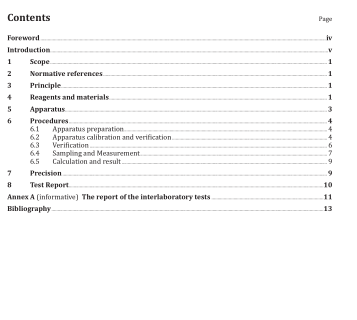ISO 17198:2014 pdf download.Dimethyl ether (DME) for fuels — Determination of total sulfur, ultraviolet fluorescence method
4.3 Solvent. Use either the solvent specified in 4.3.1 or 4.3.2 or a solvent similar to that occurring in the sample under analysis. Correction for sulfur contribution from solvents used in standard preparation and sample dilution is required. Alternatively, use of a solvent with non-detectable sulfur contamination relative to the unknown sample makes the blank correction unnecessary.
4.3.1 n-hexane, reagent grade.
4.3.2 Toluene, reagent grade.
4.4 Sulfur compounds, compounds with a minimum purity of 99 mass %. Examples are given in 4.4.1 to 4.4.4. Where the purity of these compounds is less than 99 mass %, the concentrations and nature of all impurities are to be established. Certified reference materials from accredited suppliers are suitable alternatives to the compounds listed in 4.4.1 to 4.4.4.
4.4.1 Dibutyl sulfide (DBS). 4.4.2 Dibutyl disulfide (DBDS).
4.4.3 Dibenzothiophene (DBT).
4.4.4 Thionaphthene (benzothiophene) (TNA).
4.5 Sulfur stock solution. Prepare a stock solution of sulfur content approximately 1 000 mg/l by accurately weighing the appropriate quantity of sulfur compound (4.4) in a volumetric flask (5.9). Ensure complete dissolution with solvent (4.3). Calculate the exact sulfur concentration of the stock solution to the nearest 1 mg/l. This stock solution is used for the preparation of calibration standards. As an alternative procedure, a sulfur stock solution of approximately 1 000 mg/kg can be prepared by accurately weighing the appropriate quantity of sulfur compound (4.4). Take precautions to ensure that evaporation of the solvent and/or sulfur compounds is not causing weighing errors.
4.6 Calibration standards. Prepare the calibration standards by dilution of the stock solution (4.5) with the selected solvent (4.3). Calculate the exact sulfur content of each calibration standard. Calibration standards with a known sulfur concentration, in mg/l or mg/kg, can be obtained with a volume/volume (or mass/mass) dilution of the stock solution at 1 000 mg/l or mg/kg. Other practices are possible but those mentioned above avoid any density correction. New calibration standards should be prepared on a regular basis depending upon the frequency of use and age. When stored at low temperature, typically in a refrigerator, the calibration standards, with a sulfur content above 30 mg/kg or mg/l have at least a one month use of life. Below this sulfur content (30 mg/kg), the shelf life should be reduced.
4.7 Quality control samples.
These are stable samples representative of the materials being analysed, that have a sulfur content that is known by this test method over a substantial period of time. Alternatively, there are standard materials with a certified value commercially available. Ensure before use that the material is within its shelf life.
5 Apparatus
5.1 Furnace, comprising an electric device, capable of maintaining a temperature sufficient to pyrolyse all of the sample and oxidize all sulfur to sulfur dioxide (SO 2 ). Follow manufacturer’s direction for the setting of the temperature. It can be set either in a horizontal or vertical position.
5.2 Combustion tube, of quartz, constructed to allow the direct injection of the sample into the heated oxidation zone of the furnace (5.1). The combustion tube shall have side arms for the introduction of oxygen and carrier gas. The oxidation section shall be large enough to ensure complete combustion of the sample. It can be set either in a horizontal or vertical position.
5.3 Flow controllers, capable of maintaining a constant supply of oxygen and carrier gas.
5.4 Vapour drier, capable of removing water vapour formed during combustion prior to measurement by the detector (5.5). 5.5 UV fluorescence detector, a selective and quantitative detector capable of measuring light emitted from the fluorescence of sulfur dioxide by UV light.
5.6 Microsyringe, capable of accurately delivering between 5 μl and 50 μl quantities. Follow the manufacturer’s instructions for determining the length of the needle required. For vertical injection, syringes with a polytetrafluoroethylene (PTFE) plunger are recommended. 5.7 Sample inlet system, positioned either vertically or horizontally. It shall consist of a direct- injection inlet system capable of allowing the quantitative delivery of the material to be analysed into an inlet carrier stream which directs the sample into the oxidation zone at a controlled and repeatable rate. A syringe drive mechanism, which discharges the sample from the microsyringe at a constant rate of approximately 1 μl/s maximum, is required.ISO 17198 pdf download.ISO 17198-2014 pdf download
